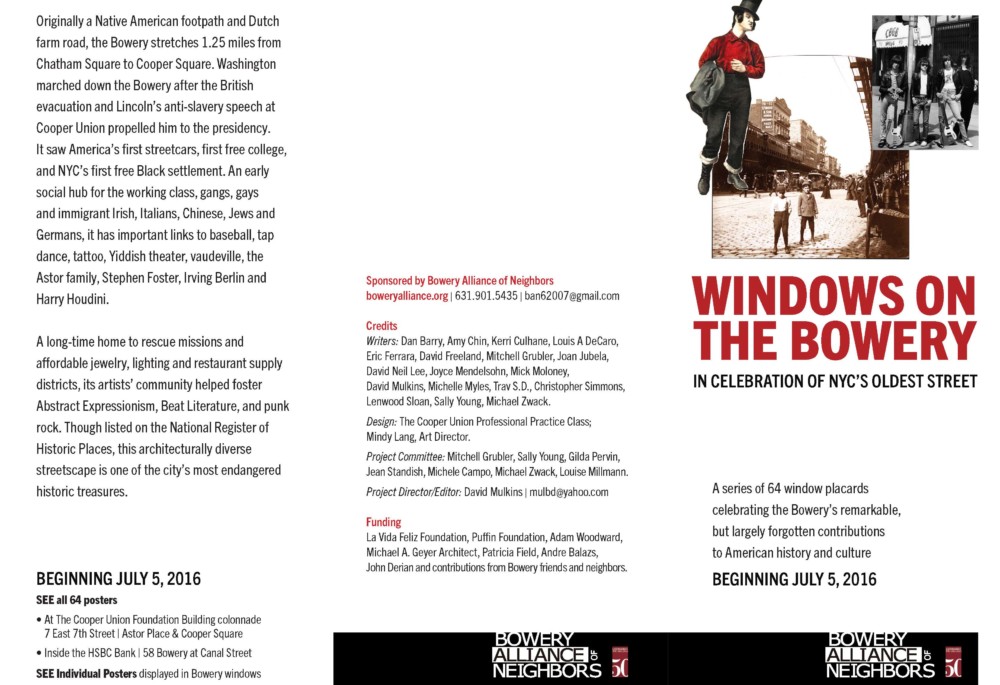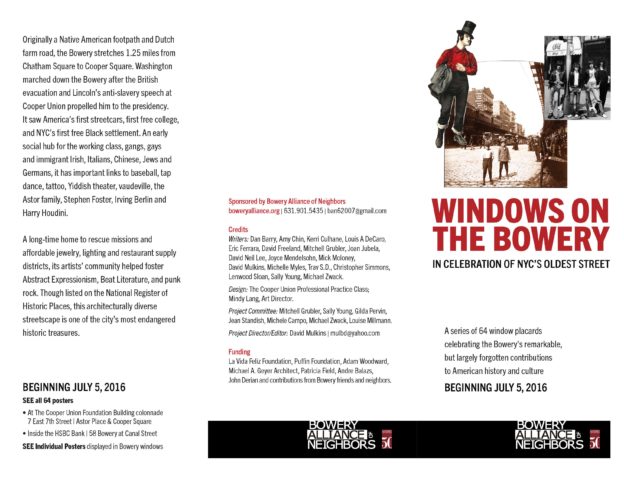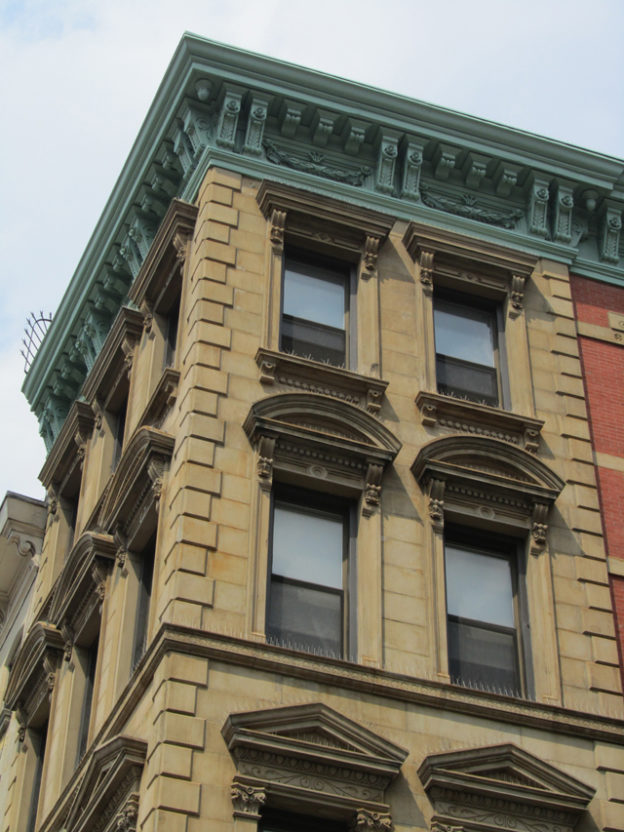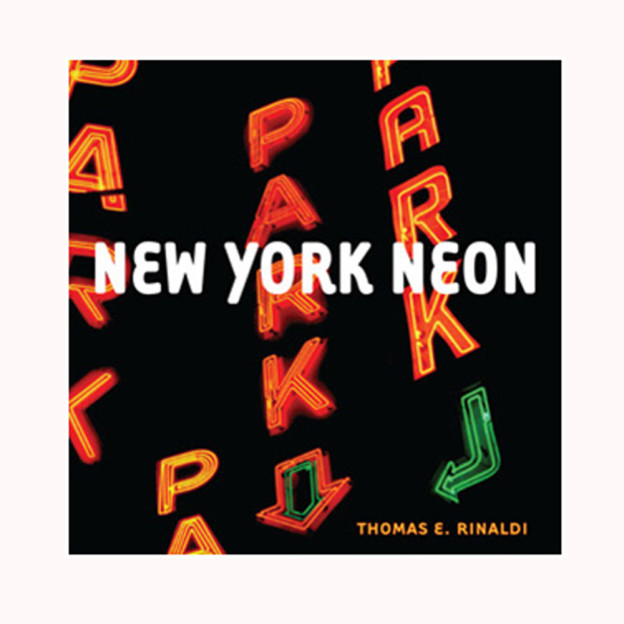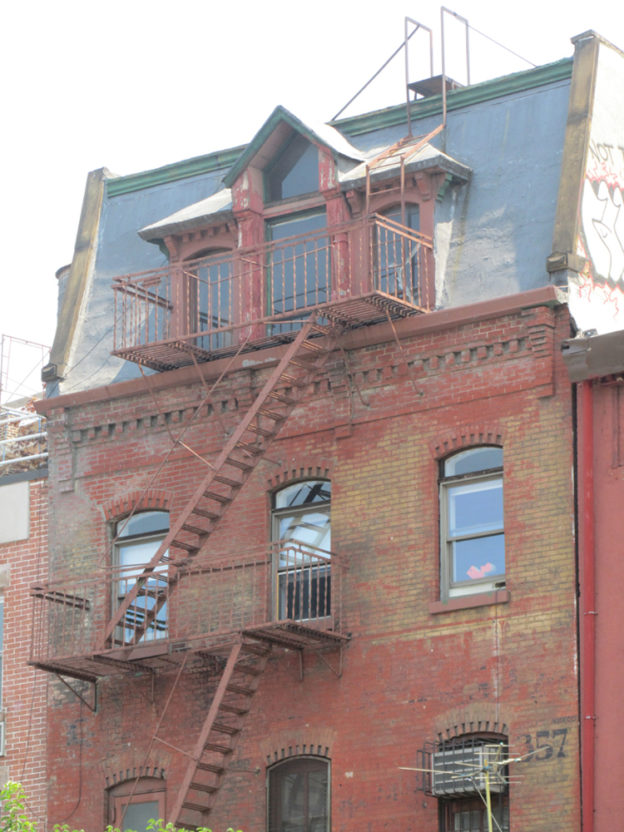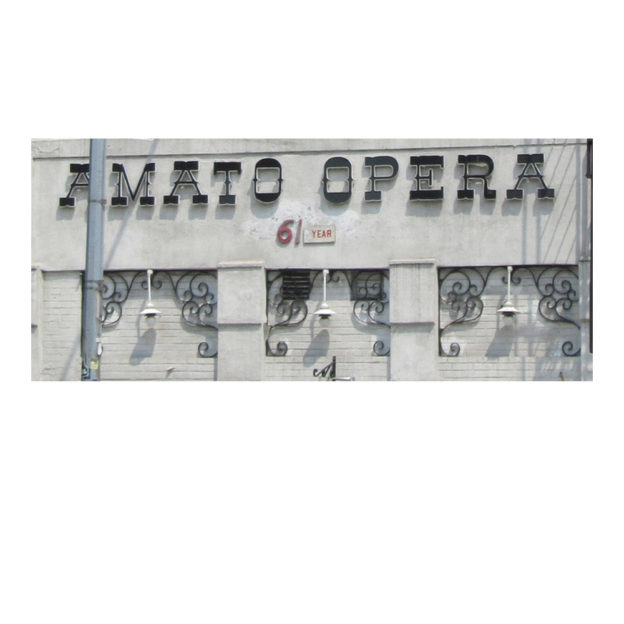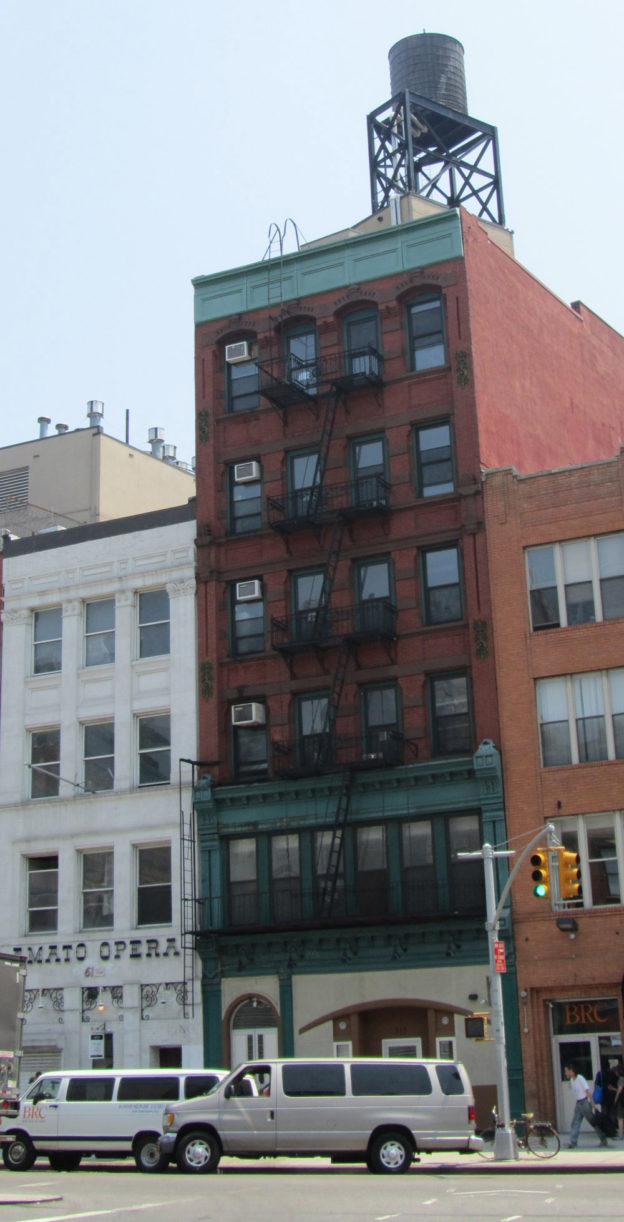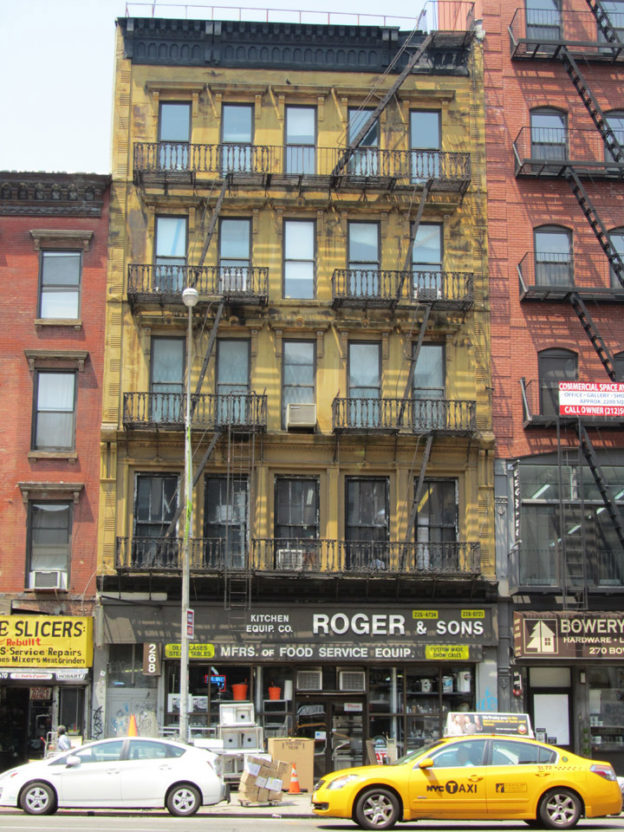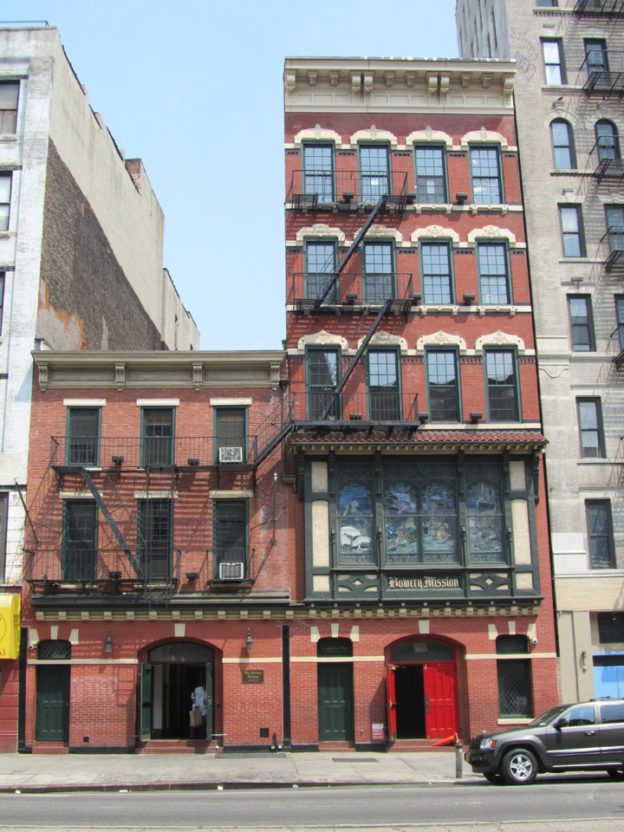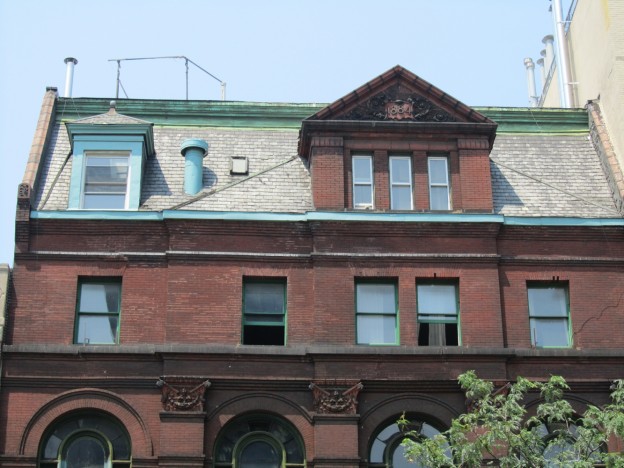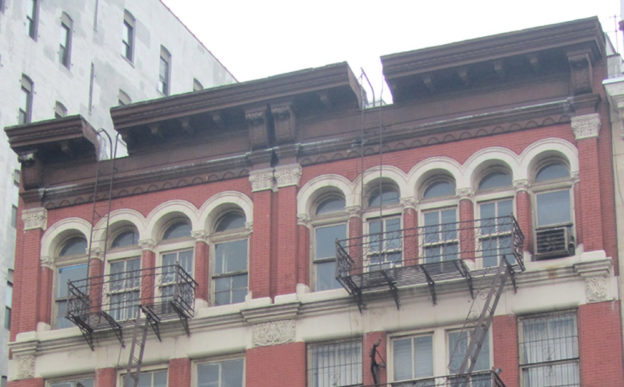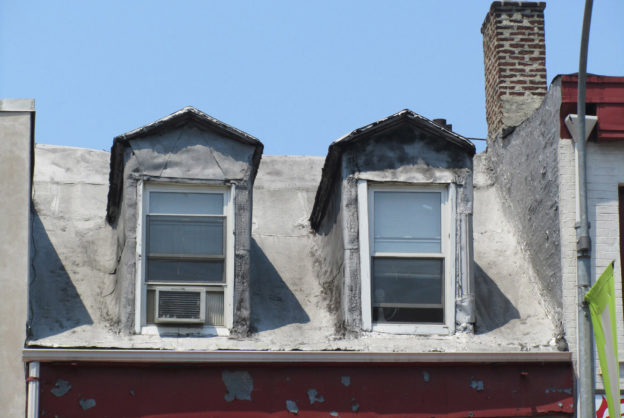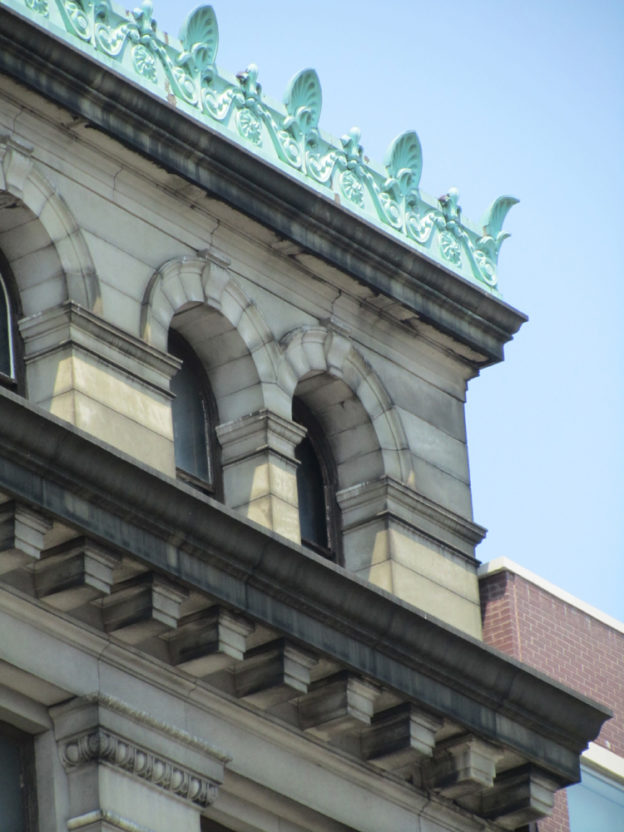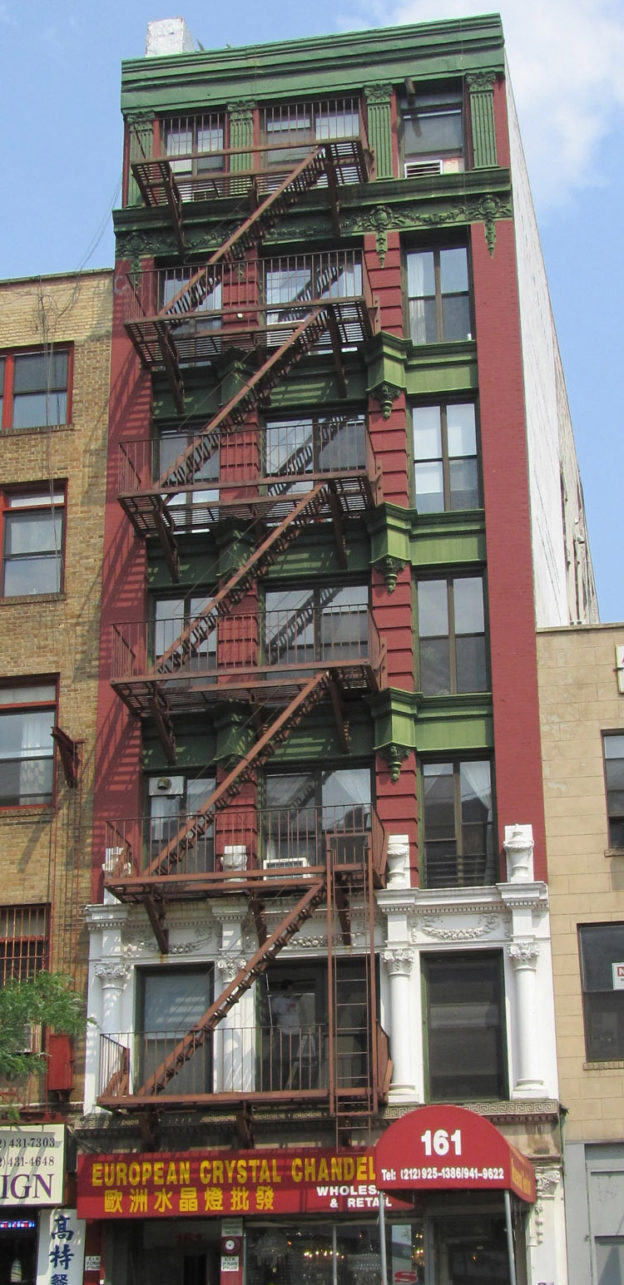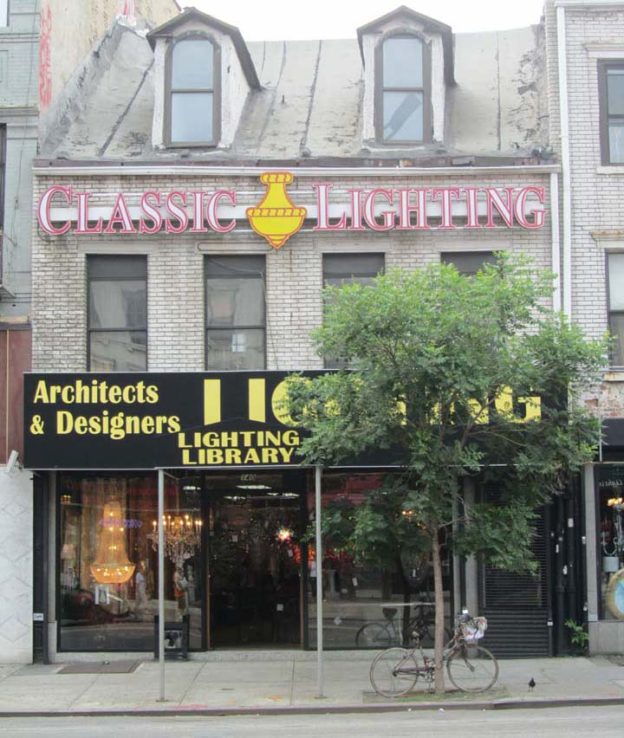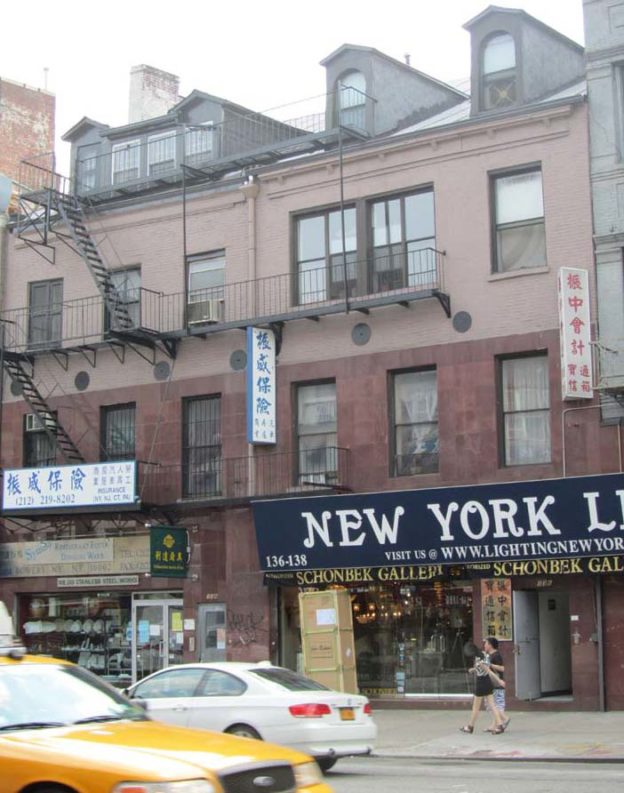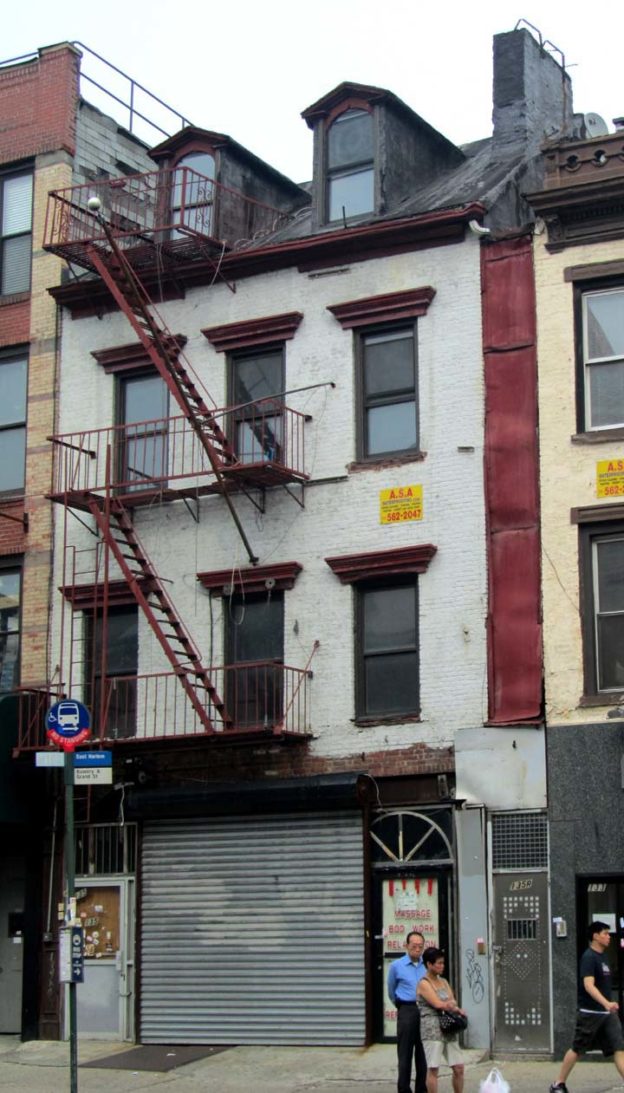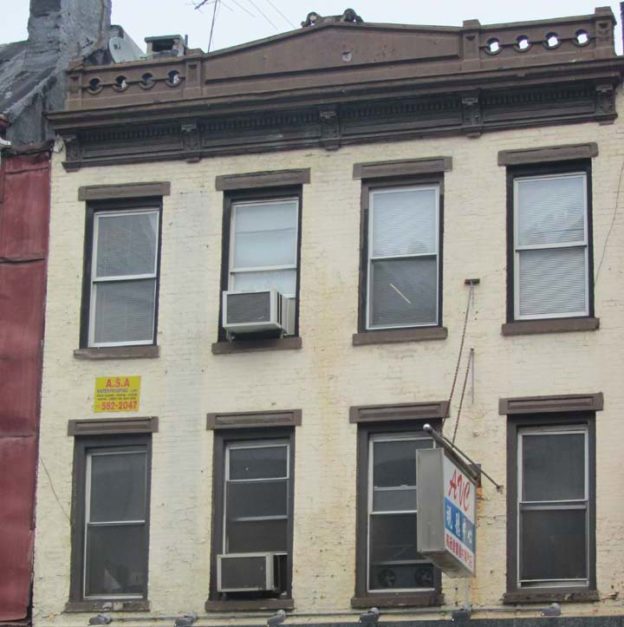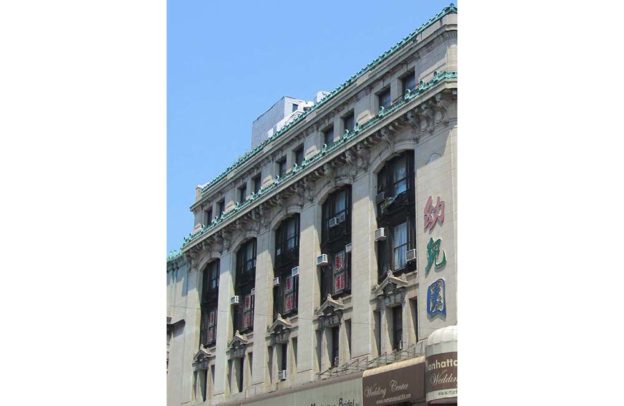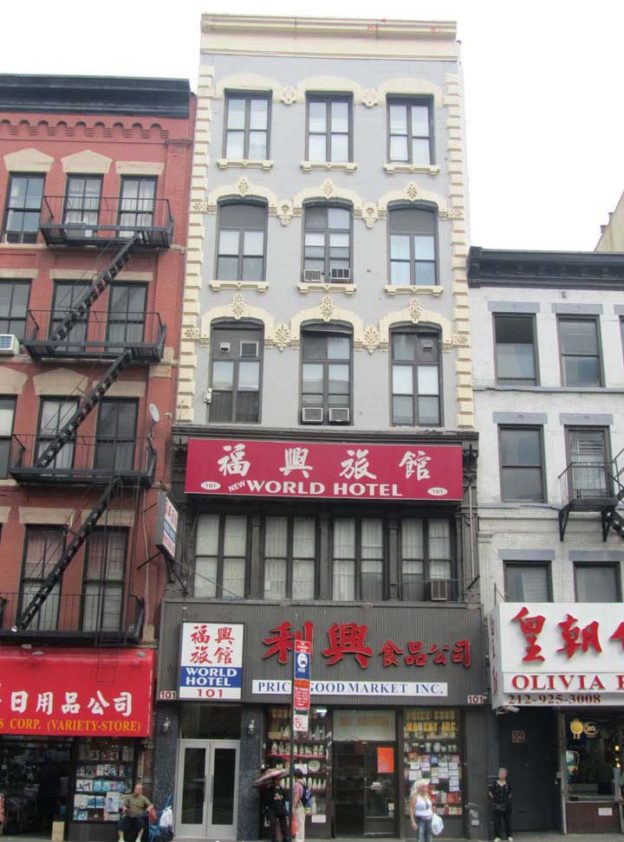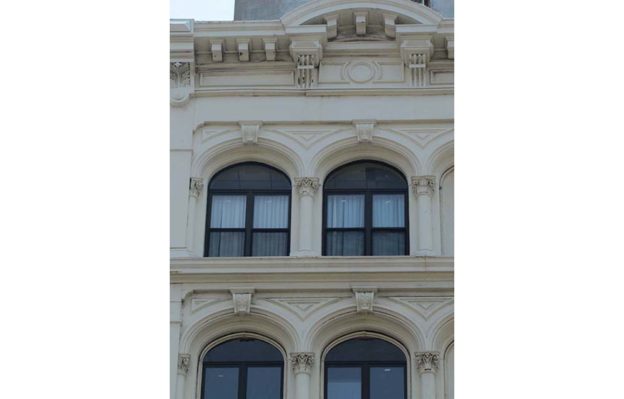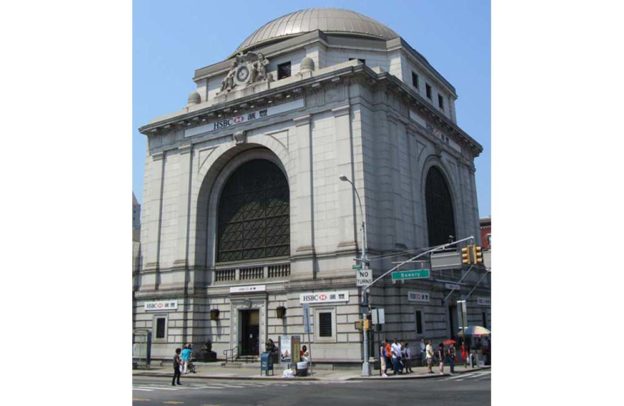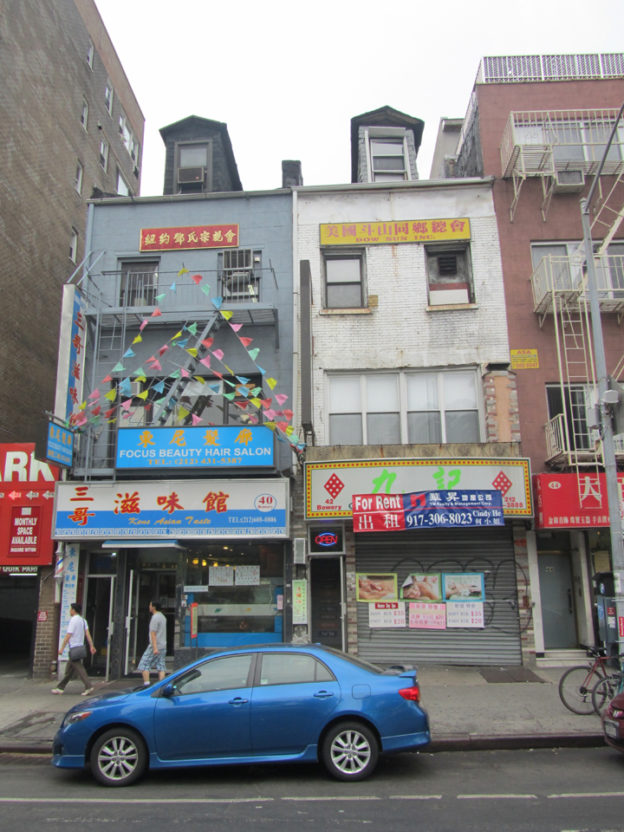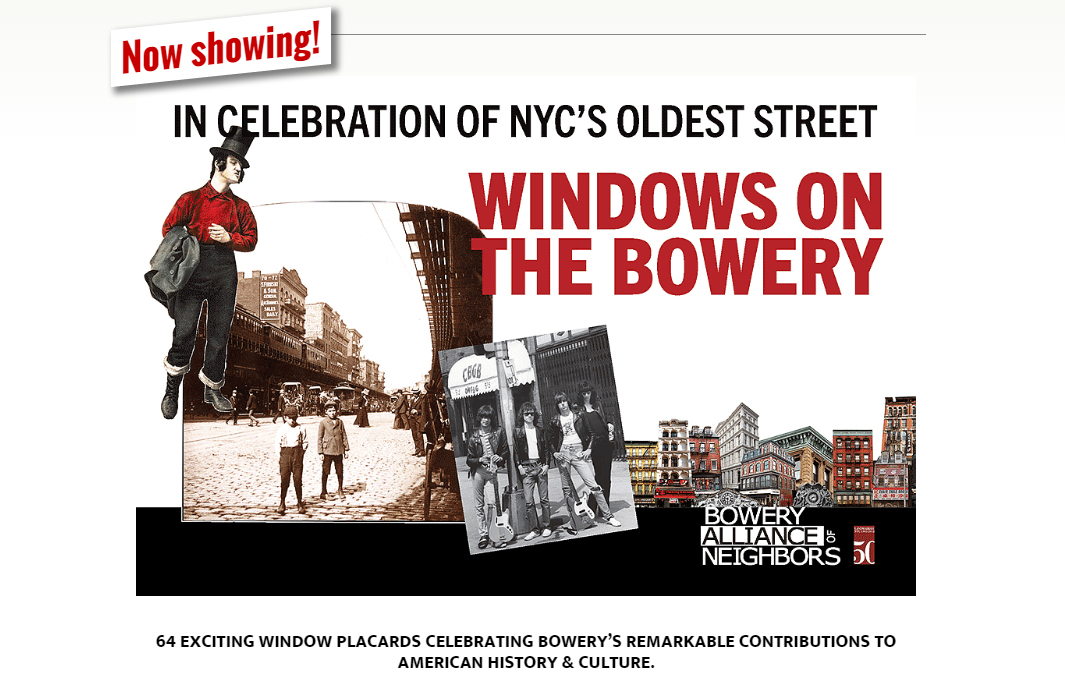 Originally a Native American footpath and Dutch farm road, the Bowery stretches 1.25 miles from Chatham Square to Cooper Square. Washington marched down the Bowery after the British evacuation and Lincoln’s anti-slavery speech at Cooper Union propelled him to the presidency. It saw America’s first streetcars, first free college, and NYC’s first free Black settlement. An early social hub for the working class, gangs, gays and immigrant Irish, Italians, Chinese, Jews and Germans, it has important links to baseball, tap dance, tattoo, Yiddish theater, vaudeville, the Astor family, Stephen Foster, Irving Berlin and Harry Houdini.
Originally a Native American footpath and Dutch farm road, the Bowery stretches 1.25 miles from Chatham Square to Cooper Square. Washington marched down the Bowery after the British evacuation and Lincoln’s anti-slavery speech at Cooper Union propelled him to the presidency. It saw America’s first streetcars, first free college, and NYC’s first free Black settlement. An early social hub for the working class, gangs, gays and immigrant Irish, Italians, Chinese, Jews and Germans, it has important links to baseball, tap dance, tattoo, Yiddish theater, vaudeville, the Astor family, Stephen Foster, Irving Berlin and Harry Houdini.
A long-time home to rescue missions and affordable jewelry, lighting and restaurant supply districts, its artists’ community helped foster Abstract Expressionism, Beat Literature, and punk rock. Though listed on the National Register of Historic Places, this architecturally diverse streetscape is one of the city’s most endangered historic treasures.
The Bowery is one of New York’s most storied streets with a rich and varied past that reflects the hurly-burly history of New York City itself. As Manhattan’s oldest thoroughfare, the Bowery began as a Native American trail and originally extended the length of the island north to south. New York’s early Dutch settlers widened the trail for their own use to connect New Amsterdam at the tip of Manhattan with their farms, or bouweriesfarther north. This “Bouwerie Lane” became simply “Bowery Lane” under the English in 1813 and the name has remained unchanged since.
The Bowery remains an architecturally rich area with a unique mix of Federal-style rowhouses, grand institutional buildings, tenements and commercial loft buildings, each type speaking to a different era in the boulevard’s storied history. Many of these buildings were spared because the elevated rail line, which was removed in the 1950s, deterred speculative development for decades. In recent years, however, new large-scale development has increased and is putting the built heritage of the Bowery greatly at risk.
To learn more about the Bowery click here
The Bowery on film dates to the earliest days of cinema, when its rowdy, amoral reputation provided titillating material for early peep shows, one-reelers, and silent era features like Raoul Walsh’s REGENERATION (1915). It figured even more prominently in the early sound era when Boweryesque song and slang were exploited to the full in films like SHE DONE HIM WRONG (1933) with Mae West. The ravaged lives of the Bowery’s skid row have long fascinated artists, as seen in the documentary classic ON THE BOWERY (1956). Scott Elliott’s SLUMMING IT gives a wonderful overview of Bowery history, and Mandy Stein’s BURNING DOWN THE HOUSE is a poignant appreciation of Hilly Kristal’s legendary CBGB, made during the club’s final days.
With the Bowery imperiled by developers at every turn, we end the series with THE VANISHING CITY, a powerful look at the forces that threaten to obliterate the character and culture of our communities.
For more information about this film series click here
Presented by: Bowery Alliance of Neighbors
www.boweryalliance.org
May 8, 2014
Sponsored by Lower East Side Preservation Initiative
Neon signage – bold, colorful, flashy, and often beautiful – is emblematic of New York itself, and particularly the Lower East Side with its exuberant and diverse immigration, political, and cultural history.
Join Tom Rinaldi, architectural designer and author of New York Neon, in a rollicking tour of some of the most striking and historically interesting Lower East Side neon, including Katz’s, Russ and Daughter’s, Gringer Appliances, and lesser known gems.
Thursday, May 8th, 6:30 PM
Meet in front of John’s Restaurant 302 East 12th St. just west of 2nd Ave.
Admission: $20 LESPI Members: $15
Reservations are limited: advance ticket purchase recommended
Purchase tickets at www.NYCharities.org
Contact Richard:347-827-1846 or info@LESPI-nyc.org
You can purchase New York Neon here
357 Bowery;
Carl Pfeiffer;
1870|
This building is another vestige of the once large German population in the Bowery area. It is also reflective of the necessity for fire insurance in the 1870s, when fires were common and a major problem in dense urban areas like New York. This building is a smaller-scale example of insurance-company building styles of the 1870s, the design of this building having been inspired by more prominent insurance-company buildings. It was fashionable during this time, especially for insurance buildings, to possess mansard roofs, dormers, cast-iron storefronts and high basements, as this building has. The building today is completely residential and is a New York City landmark.
Julius Rockwell & Son;
1899|
This four-story brick building was a cigar factory from 1899 until 1926, when it became Holy Name Mission. The mission served the homeless until 1962. In 1964 it became the Amato Opera and saw 61 seasons before it closed and went up for sale in 2009.
F. W. Klemt;
1883|
Originally only three stories, this building gained an additional three stories in the 1880s by H. Bruns, the owner of the building. He incorporated his initials as decorative elements that can still be seen on the second story and on the fire escape. It was a lodging house in the 1880s and continues to lodge men today, as it is home to the Bowery Residents’ Committee.
J. and D. Jardine;
1871|
This five-story Italianate building is unusual and stands out on the Bowery because of its yellow color. The yellow façade is clad in Dorchester stone, a sandstone from Nova Scotia and New Brunswick, Canada, that was especially popular in the 1870s and 1880s. This building retains many original features, such as its window hoods, brackets, cornice and ironwork. The building was used as a dwelling and store until the early 1880s, when it became the Great Northern Hotel and later the Windsor Lodging House, which was notorious for thieves.
227 Bowery;
William Jose, Marshal L. and Henry C.;
Emery, Diffendale and Kubec;
1876; alterations 1908–1909; renovations 2001|
The Bowery Mission was organized in 1879 and at the time was the third rescue mission in America. It was organized as a response to the rampant homelessness on the Bowery after the Civil War. The mission moved to the five story building (which originally was a coffin factory) in 1909, and President William Taft visited later that year. After 1909 this building received upgrades including fireproofing, and it also received a new chapel and façade. The Tudor Revival style was chosen because it is emulative of an English inn, suggesting a welcoming public place. The stained-glass windows depict the parable of the Prodigal Son and are attributed to Tiffany-trained artist Benjamin Sellers. The three-story building next to the mission is a circa 1830 Federal-style house. It was modified in 1895 to the Italianate style it retains today and was unified with the mission next door in 1980.
222 Bowery;
Bradford L. Gilbert;
1884–1885|
This was the first YMCA to open in New York City and originally was called the Young Men’s Institute. It was built to provide young men with shelter and physical and social enrichment as an alternative to the overcrowded flophouse accommodations that dominated the Bowery. It remained a YMCA until 1932, when it was converted to lofts/residential space subsequently inhabited by many world-renowned artists. It is not common for an institutional building to be designed in the Queen Anne style—a style usually reserved for domestic architecture. This building has been a New York City landmark since 1998.
219–221 Bowery;
James E. Ware;
1889|
The Alabama Hotel was a flophouse that stayed in business until 1967, when it was converted to artists’ lofts. This building retains most of its original features and possesses a distinguished Queen Anne façade. It was designed by James E. Ware, most famous for developing the dumbbell tenement.
215 Bowery;
Charles Kinkel;
1872|
This limestone-faced building was built for the New Amsterdam Savings Bank in 1872, which failed by 1876. It then became Germania Bank, reflective of the large German population near this area at the end of the 19th century. This building was constructed on an irregularly narrow lot, and the heavy stonework and quoins enhance its narrow façade.
Unknown architect;
ca. 1810|
No. 206 Bowery remains very intact, especially compared to its next-door neighbors, which originally matched it. These buildings were constructed as a group around 1810 and are connected by one-foot thick masonry party walls. No. 206 retains a gambrel roof and a pair of pedimented gable dormers
190 Bowery/1–3 Spring Street;
Robert Maynicke;
1898–99|
Beginning in the 1840s, the area east of the Bowery was called Kleindeutschland because of the enormous German population. By the end of the 19th century, many of these immigrants had well-established institutions in their neighborhoods, and the built environment reflected this. The Germania Bank was one such building, and its architect, Robert Maynicke, immigrated to New York from Germany and trained at Cooper Union, just north of this building. This structure remained an operating bank until 1966, when it closed because of dwindling economic conditions along the Bowery. Photographer Jay Maisel purchased the building for $102,000 that same year and continues to live with his family in this 79-room, 35,000-square-foot structure today. New York magazine called this purchase “the greatest real-estate coup of all time.” This opulent limestone and granite Beaux-Arts bank-turned-residence is virtually intact—though badly scarred by graffiti—and has been a New York City landmark since 2005.
William Dilthey;
1900|
This ornate, seven-story building was originally a factory and commercial space. The building is Renaissance Revival and Neo-Classical in style and features a carved limestone front that extends to the second story. The stonework incorporates pilasters with unfluted shafts and Italian Renaissance capitals, which are capped with vases. The seventh story possesses fluted pilasters treated in the same style.
Unknown architect;
ca. 1799|
This Federal-style building may be another 18th century survivor. Records show that from 1799– 1802 a butcher occupied this address. It retains original features such as its steeply pitched roof, and, if one looks closely, paneled stone lintels on the second story. Unfortunately, its twin pedimented dormers were removed in 2011.
Unknown architect;
1798|
New York City has a small collection of 18th-century buildings, and these two survivors are part of it. They retain Federal features such as their steeply pitched roofs, twin pedimented dormers, Flemish bond, and No. 134 possesses an end chimney. These buildings also share an early wrought-iron fire escape. Sculptor Eva Hesse (1936–1970) had a studio in the half story of No. 134.
133 BOWERY;
Unknown architect;
ca. 1813|
This originally was a Federal-style building that housed a soap and candle manufacturing business. It lost its peaked roof in 1874, when the roof was raised to create a third story. The original Flemish-bond brickwork can still be seen on the second story. The cornice was removed in 2011.
124–126 Bowery/230 Grand Street;
York and Sawyer;
1901|
Architects York and Sawyer were bank- and hospital design specialists, whose prolific work in Manhattan includes this bank building. This colossal Beaux-Arts structure is flanked by its neighbor, the Bowery Savings Bank, which was designed by McKim, Mead and White. Interestingly enough, York and Sawyer were trained in McKim, Mead and White’s office. This monumental building is clad in limestone and features highly ornamental Renaissance façades and copper cornices supported by heavy stone brackets.
101 BOWERY;
William Jose;
1875|
This six-story commercial building once was home to “Mr. Worth’s Renowned Museum of Living Curiosities,” a testament to the Bowery’s vaudeville past. This Neo-Grec structure has intact architectural details like stone quoins, incised stone lintels, sills and window surrounds.
54–58 Bowery;
Clarence W. Brazer;
1924|
This grand bank dominates the corner of Canal and Bowery, and references the Manhattan Bridge’s access across the street in design and materials. This Beaux-Arts beauty features a bronze dome, carved stone ornamentation, arches, pilasters, scrolls, keystones, a classical entablature and a balustrade. The Bowery façade possesses a clock that is flanked by Native American and seamen figures and is topped with an eagle. The building still serves as a bank today. It was designated a city landmark in 2011.
Unknown architect;
1807|
These two Federal-style houses have stood on the Bowery for over 200 years. No. 40 was the headquarters for the Bowery Boys—a nativist gang— in the mid-19th century. The infamous July 4th,1857, riot between the Irish gang of the Dead Rabbits and the Bowery Boys began in the saloon in No. 40 and lasted three days. These buildings retain original features such as Flemish-bond masonry, steeply pitched roofs with single peaked dormers on the front and back, gable-end chimneys and some stone lintels and sills that still remain.
 Originally a Native American footpath and Dutch farm road, the Bowery stretches 1.25 miles from Chatham Square to Cooper Square. Washington marched down the Bowery after the British evacuation and Lincoln’s anti-slavery speech at Cooper Union propelled him to the presidency. It saw America’s first streetcars, first free college, and NYC’s first free Black settlement. An early social hub for the working class, gangs, gays and immigrant Irish, Italians, Chinese, Jews and Germans, it has important links to baseball, tap dance, tattoo, Yiddish theater, vaudeville, the Astor family, Stephen Foster, Irving Berlin and Harry Houdini.
Originally a Native American footpath and Dutch farm road, the Bowery stretches 1.25 miles from Chatham Square to Cooper Square. Washington marched down the Bowery after the British evacuation and Lincoln’s anti-slavery speech at Cooper Union propelled him to the presidency. It saw America’s first streetcars, first free college, and NYC’s first free Black settlement. An early social hub for the working class, gangs, gays and immigrant Irish, Italians, Chinese, Jews and Germans, it has important links to baseball, tap dance, tattoo, Yiddish theater, vaudeville, the Astor family, Stephen Foster, Irving Berlin and Harry Houdini.